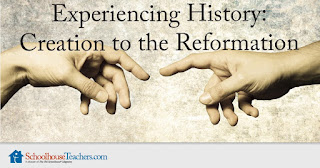This post contains affiliate links - using affiliate links from Homeschool Coffee Break helps fuel this blog and our homeschool - thank you!
We're coming up on several days of seasonal celebrations that seem very different, but really are related. And there are very different views on which ones to celebrate, and how! Our family is pretty low key about all of them, but since I'm fascinated by history, I always like to gather some background information about holidays and traditions. Here's a little round-up of the histories of Halloween, Reformation Day, All Saints Day, and All Souls Day.
Let's start with Halloween, which often gets mixed reviews. For most of us, it's a day to dress up in costumes ranging from ridiculous to disturbing, and from cute to terrifying. Costume parties, candy, and fun! However, most of us also know that the roots of our Trick or Treating are a little darker - a pagan Celtic sacrifice to appease evil spirits. It was believed that evil spirits were sent to attack humans, and the best chance of escape was to disguise yourself as a spirit, and so started the custom of dressing up. The name Halloween comes from All Hallows Eve, because medieval Christians celebrated All Hallows Day on November 1st.
I'll get to All Hallows in a moment, but before that let's talk about an event that Christians often commemorate on October 31st in addition to - or, in some cases, instead of - Halloween. October 31st is Reformation Day, because on that date in 1517, Martin Luther nailed his 95 Theses to the church door in Wittenburg, Germany.

Luther was a Catholic priest and scholar whose personal study of Scripture showed what he believed were differences in what the Bible said and what the Church was actually practicing. He wrote his challenges to these practices as points of debate, or theses, and posted them on the church door. These were translated, published, and distributed across Germany, and thus began the Protestant Reformation. Luther was put on trial for heresy, but stood firm even through the threat of excommunication. Luther hoped that the church would return its focus to salvation by grace through faith, and the assurance that God's grace was freely given to those who believe. Those who followed his teachings came to be known as Lutherans, and eventually many Protestant churches arose as a result of his influence. One man who had experienced God's grace for his own flaws stood firm on the truth of Scripture and God used him to change the world. I'd say that's something Christians should indeed remember and honor!


Now let's go on to All Hallows Day. All Hallows or All Saints' Day was first celebrated in the spring of the year 509, but in 837, Pope Gregory III changed the date to November 1st. The church had traditionally commemorated Christian martyrs, and all Christian saints were included in this special day. During the Reformation, Protestant churches realized that when the New Testament referred to saints, it meant all believers. Thus, All Saints' Day became a day to celebrate the unity of the Church.
November 2nd is All Souls' Day, and although it sounds like the same thing as All Saints' but with a slightly different name, it's not quite that simple. All Souls' is primarily celebrated by Roman Catholics, who dedicate the day to prayer and give alms in memory of their deceased loved ones. They may also prayer for the souls of the dead, believing that this will shorten their stay in purgatory so they can transition to heaven.
In recent years, the sugar skulls of Dia de los Muertos or Day of the Dead have become popular for decorating and face painting. Dia de los Muertos is celebrated in parts of Mexico on November 1st and 2nd, coinciding with All Saints' and All Souls' Days. Indigenous peoples combined Christian celebrations with their ancient beliefs of honoring deceased loved ones. They use candles, flowers, food and drink, toys, and candies to decorate elaborate altars in their homes. They believe the spirits of the deceased are able to visit on those days. On the afternoon of November 2nd, they often take their celebrating to the cemeteries where they play game, enjoy music, and reminisce. Most of the Dia de los Muertos celebrations are very family-oriented and are festive rather than morbid or scary. Sugar skulls became part of these celebrations in Mexico during the 18th century.
Find out more in my post: Virtual Refrigerator - Papel Picado for Dia de los Muertos

If you'd like to learn more about Martin Luther and the Reformation, SchoolhouseTeachers.com has lots of resources for you. For a more detailed listing, see my Reformation Day Resources post linked above. Resources include:
A three-hour documentary with study guide, suitable for high schoolers - This Changed Everything.
The middle school course Experiencing Christianity: Creation to the Reformation, which guides students through a tour of Bible and church history starting with Creation and ending with the time of Martin Luther and the Reformation.

The video series They Lived for God is geared for high school age students, and includes videos about Jan Hus, Martin Luther, and William Tyndale.

Which is these special days do you celebrate? Leave a comment and let me know!
Don't miss a coffee break! Subscribe to Homeschool Coffee Break by Email!I'll get to All Hallows in a moment, but before that let's talk about an event that Christians often commemorate on October 31st in addition to - or, in some cases, instead of - Halloween. October 31st is Reformation Day, because on that date in 1517, Martin Luther nailed his 95 Theses to the church door in Wittenburg, Germany.

Luther was a Catholic priest and scholar whose personal study of Scripture showed what he believed were differences in what the Bible said and what the Church was actually practicing. He wrote his challenges to these practices as points of debate, or theses, and posted them on the church door. These were translated, published, and distributed across Germany, and thus began the Protestant Reformation. Luther was put on trial for heresy, but stood firm even through the threat of excommunication. Luther hoped that the church would return its focus to salvation by grace through faith, and the assurance that God's grace was freely given to those who believe. Those who followed his teachings came to be known as Lutherans, and eventually many Protestant churches arose as a result of his influence. One man who had experienced God's grace for his own flaws stood firm on the truth of Scripture and God used him to change the world. I'd say that's something Christians should indeed remember and honor!
Here I stand; I can do no otherwise. God help me. Amen! ~Martin Luther, in a speech at the Diet of Worms, 1521Find out more about Martin Luther and the Reformation in my posts: From the High School Lesson Book - Halloween and Reformation Day and Reformation Day Resources from SchoolhouseTeachers.com


Now let's go on to All Hallows Day. All Hallows or All Saints' Day was first celebrated in the spring of the year 509, but in 837, Pope Gregory III changed the date to November 1st. The church had traditionally commemorated Christian martyrs, and all Christian saints were included in this special day. During the Reformation, Protestant churches realized that when the New Testament referred to saints, it meant all believers. Thus, All Saints' Day became a day to celebrate the unity of the Church.
November 2nd is All Souls' Day, and although it sounds like the same thing as All Saints' but with a slightly different name, it's not quite that simple. All Souls' is primarily celebrated by Roman Catholics, who dedicate the day to prayer and give alms in memory of their deceased loved ones. They may also prayer for the souls of the dead, believing that this will shorten their stay in purgatory so they can transition to heaven.
In recent years, the sugar skulls of Dia de los Muertos or Day of the Dead have become popular for decorating and face painting. Dia de los Muertos is celebrated in parts of Mexico on November 1st and 2nd, coinciding with All Saints' and All Souls' Days. Indigenous peoples combined Christian celebrations with their ancient beliefs of honoring deceased loved ones. They use candles, flowers, food and drink, toys, and candies to decorate elaborate altars in their homes. They believe the spirits of the deceased are able to visit on those days. On the afternoon of November 2nd, they often take their celebrating to the cemeteries where they play game, enjoy music, and reminisce. Most of the Dia de los Muertos celebrations are very family-oriented and are festive rather than morbid or scary. Sugar skulls became part of these celebrations in Mexico during the 18th century.
Another popular decoration for Day of the Dead in Mexico is Papel Picado. The name means 'pieced paper' and it refers to banners made of cut paper designs.
Find out more in my post: Virtual Refrigerator - Papel Picado for Dia de los Muertos

As Christians, we don't believe that spirits of the deceased can come visit with us, but I do like the idea of honoring the memories of our loved ones and remembering them with joy. And I definitely like that we can look forward to seeing them in heaven some day.
Jesus said to her, "I am the resurrection and the life. The one who believes in me will live, even though they die; and whoever lives by believing in me will never die. Do you believe this?" She said to him, "Yes, Lord; I believe that you are the Messiah, the Son of God, who is to come into the world." ~John 11:25-27~~~~~~~~~~~~~~~
If you'd like to learn more about Martin Luther and the Reformation, SchoolhouseTeachers.com has lots of resources for you. For a more detailed listing, see my Reformation Day Resources post linked above. Resources include:
A three-hour documentary with study guide, suitable for high schoolers - This Changed Everything.
The middle school course Experiencing Christianity: Creation to the Reformation, which guides students through a tour of Bible and church history starting with Creation and ending with the time of Martin Luther and the Reformation.

The video series They Lived for God is geared for high school age students, and includes videos about Jan Hus, Martin Luther, and William Tyndale.

Which is these special days do you celebrate? Leave a comment and let me know!
This post is linked at the Homeschool Linky Party on the Homeschool Review Crew blog.
©2006-2018 Homeschool Coffee Break. All rights reserved. All text, photographs, artwork, and other content may not be reproduced or transmitted in any form without the written consent of the author. http://kympossibleblog.blogspot.com/
We are a participant in the Amazon Services LLC Associates Program, an affiliate advertising program designed to provide a means for us to earn fees by linking to Amazon.com and affiliated sites.













































1 comments:
wow... I learned so much. glad I stopped to read.
Post a Comment
I love comments! It's like visiting over a virtual cup of coffee.